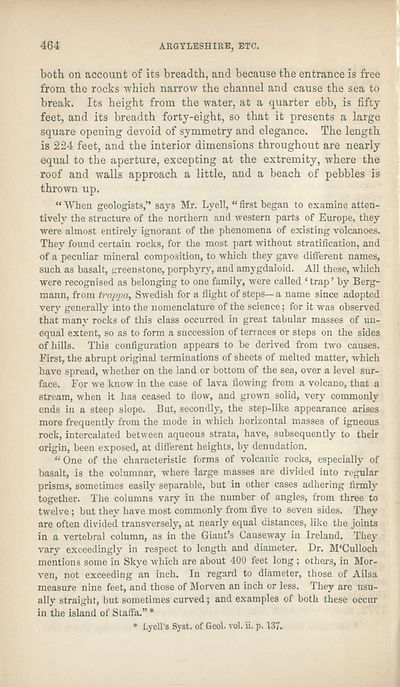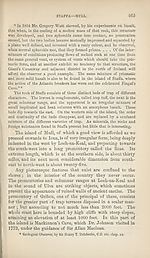Download files
Complete book:
Individual page:
Thumbnail gallery: Grid view | List view

464
ARGYLESHIRE, ETC.
both on account of its breadth, and because the entrance is free
from the rocks which narrow the channel and cause the sea to
break. Its height from the water, at a quarter ebb, is fifty
feet, and its breadth forty-eight, so that it presents a large
square opening devoid of symmetry and elegance. The length
is 224 feet, and the interior dimensions throughout are nearly
equal to the aperture, excepting at the extremity, where the
roof and walls approach a little, and a beach of pebbles is
thrown up.
“ When geologists,” says Mr. Lyell, “ first began to examine atten¬
tively the structure of the northern and western parts of Europe, they
were almost entirely ignorant of the phenomena of existing volcanoes.
They found certain rocks, for the most part without stratification, and
of a peculiar mineral composition, to which they gave different names,
such as basalt, greenstone, porphyry, and amygdaloid. All these, which
were recognised as belonging to one family, were called ‘ trap ’ by Berg-
mann, from trappa, Swedish for a flight of steps— a name since adopted
very generally into the nomenclature of the science; for it was observed
that many rocks of this class occurred in great tabular masses of un¬
equal extent, so as to form a succession of terraces or steps on the sides
of hills. This configuration appears to be derived from two causes.
First, the abrupt original terminations of sheets of melted matter, which
have spread, whether on the land or bottom of the sea, over a level sur¬
face. For we know in the case of lava flowing from a volcano, that a
stream, when it has ceased to flow, and grown solid, very commonly
ends in a steep slope. But, secondly, the step-like appearance arises
more frequently from the mode in which horizontal masses of igneous
rock, intercalated between aqueous strata, have, subsequently to their
origin, been exposed, at different heights, by denudation.
“One of the characteristic forms of volcanic rocks, especially of
basalt, is the columnar, where large masses are divided into regular
prisms, sometimes easily separable, but in other cases adhering firmly
together. The columns vary in the number of angles, from three to
twelve; but they have most commonly from five to seven sides. They
are often divided transversely, at nearly equal distances, like the joints
in a vertebral column, as in the Giant’s Causeway in Ireland. They
vary exceedingly in respect to length and diameter. Dr. M'Culloch
mentions some in Skye which are about 400 feet long; others, in Mor-
ven, not exceeding an inch. In regard to diameter, those of Ailsa
measure nine feet, and those of Morven an inch or less. They are usu¬
ally straight, but sometimes curved; and examples of both these occur
in the island of Staffa.” *
* Lyell’s Syst. of Geol. vol. ii. p. 137.
ARGYLESHIRE, ETC.
both on account of its breadth, and because the entrance is free
from the rocks which narrow the channel and cause the sea to
break. Its height from the water, at a quarter ebb, is fifty
feet, and its breadth forty-eight, so that it presents a large
square opening devoid of symmetry and elegance. The length
is 224 feet, and the interior dimensions throughout are nearly
equal to the aperture, excepting at the extremity, where the
roof and walls approach a little, and a beach of pebbles is
thrown up.
“ When geologists,” says Mr. Lyell, “ first began to examine atten¬
tively the structure of the northern and western parts of Europe, they
were almost entirely ignorant of the phenomena of existing volcanoes.
They found certain rocks, for the most part without stratification, and
of a peculiar mineral composition, to which they gave different names,
such as basalt, greenstone, porphyry, and amygdaloid. All these, which
were recognised as belonging to one family, were called ‘ trap ’ by Berg-
mann, from trappa, Swedish for a flight of steps— a name since adopted
very generally into the nomenclature of the science; for it was observed
that many rocks of this class occurred in great tabular masses of un¬
equal extent, so as to form a succession of terraces or steps on the sides
of hills. This configuration appears to be derived from two causes.
First, the abrupt original terminations of sheets of melted matter, which
have spread, whether on the land or bottom of the sea, over a level sur¬
face. For we know in the case of lava flowing from a volcano, that a
stream, when it has ceased to flow, and grown solid, very commonly
ends in a steep slope. But, secondly, the step-like appearance arises
more frequently from the mode in which horizontal masses of igneous
rock, intercalated between aqueous strata, have, subsequently to their
origin, been exposed, at different heights, by denudation.
“One of the characteristic forms of volcanic rocks, especially of
basalt, is the columnar, where large masses are divided into regular
prisms, sometimes easily separable, but in other cases adhering firmly
together. The columns vary in the number of angles, from three to
twelve; but they have most commonly from five to seven sides. They
are often divided transversely, at nearly equal distances, like the joints
in a vertebral column, as in the Giant’s Causeway in Ireland. They
vary exceedingly in respect to length and diameter. Dr. M'Culloch
mentions some in Skye which are about 400 feet long; others, in Mor-
ven, not exceeding an inch. In regard to diameter, those of Ailsa
measure nine feet, and those of Morven an inch or less. They are usu¬
ally straight, but sometimes curved; and examples of both these occur
in the island of Staffa.” *
* Lyell’s Syst. of Geol. vol. ii. p. 137.
Set display mode to:
![]() Universal Viewer |
Universal Viewer | ![]() Mirador |
Large image | Transcription
Mirador |
Large image | Transcription
| Antiquarian books of Scotland > Scotland/Scots > Black's picturesque tourist of Scotland > (584) |
|---|
| Permanent URL | https://digital.nls.uk/130035198 |
|---|
| Description | Thousands of printed books from the Antiquarian Books of Scotland collection which dates from 1641 to the 1980s. The collection consists of 14,800 books which were published in Scotland or have a Scottish connection, e.g. through the author, printer or owner. Subjects covered include sport, education, diseases, adventure, occupations, Jacobites, politics and religion. Among the 29 languages represented are English, Gaelic, Italian, French, Russian and Swedish. |
|---|

